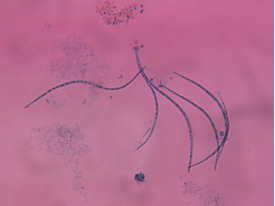In this post, Mirco Bundschuh talks about a recently granted DFG-project “The relevance of the BIOdiversity TO FUNction relationship in heterotrophic aquatic systems under stress” with the unusual acronym “BIO2FUN”.
As a regular follower of the EcotoxBlog, you are certainly familiar with the relevance of organic material from terrestrial sources for the aquatic ecosystem. Just to briefly recap: The energy and nutrients stored in those leaves is made accessible for the wider food web through the activity of heterotrophic microorganisms, mainly a specific group of aquatic fungi. These fungi degrade leaves directly via the release of enzymes or indirectly by increasing the nutritious quality of leaves for shredders through the concentration of lipids and proteins ultimately stimulating leaf consumption. The microorganisms’ community composition on leaves is, however, altered by stressors of anthropogenic origin modifying the extent to which these two functions are fulfilled. According to the pollution induced community tolerance concept, these communities adapt to stress by replacing sensitive with tolerant species. Thereby, these communities become more tolerant, which may be stressor specific.
In this context, BIO2FUN will assess in a first step the stress tolerance of complex pristine microbial communities as well as communities either adapted to a mixture of organic micropollutants and nutrients (stressor-unspecific tolerance) or fungicides (stressor-specific tolerance) originating from wastewater treatment plant effluents and vineyard runoff, respectively. Those communities’ leaf decomposition efficiency will be quantified under exposure towards increasing levels of nutrients and fungicides. By linking these responses to traits (e.g. enzymatic inventory and nutritious quality in the form of amino and fatty acid compositions) of individual aquatic fungal species, BIO2FUN has the ambition to disentangle the underlying mechanisms. Moreover, those variables allow for an estimation of the nutritious quality of leaves for shredders, which will finally be verified experimentally by assessing physiological consequences in leaf shredding invertebrates. Consequently, BIO2FUN will be a milestone for the interpretation of future studies on bottom-up directed effects in heterotrophic food webs and hence for the functioning of aquatic ecosystems.
I am sure, the project will result in a lot of interesting and likely unexpected insights and it is planned to use this blog to keep you up-to-date. If you are interested in contributing to it as part of your education (e.g., BSc or MSc thesis) please feel free to contact me directly. I will – hopefully shortly – be announcing a PhD student position to work in this project – keep your eyes open if this is of interest for you.
You may also be interested in:
Exposure history-dependent effects on ecosystem functioning in streams

